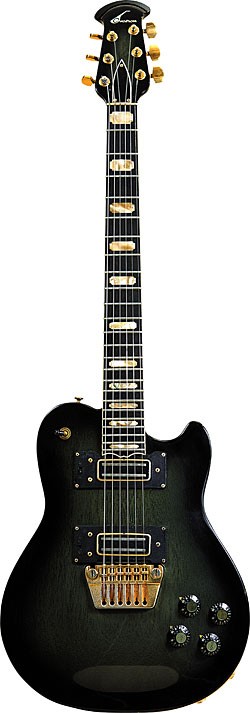
1980 Ovation UKII 1291
If there’s a Rodney Dangerfield of solidbody electric guitars, it would be named Ovation.
For more than a decade, Ovation tried unsuccessfully to leverage its achievements with revolutionary Lyracord bowlbacks and pioneering pickup systems into a presence in the lucrative solidbody market. Despite real innovations, including radical shapes, FET preamps, and high-quality products, Ovation never pulled it off. But to the end, as with this 1980 UKII 1291, it never gave up trying.
Ovation began branching into electrics as early as 1968, when it introduced a series of thinlines with German bodies, Schaller pickups, and Ovation necks. These were followed in ’72 by the more radical axe-shaped Breadwinner and Deacon, then the more conventional Preacher, Preacher Deluxe, and Viper series, all with interesting electronics and solid craftsmanship. All were dogs in the market, despite good press reception.
As you might expect from the Kaman Corporation, what makes the UKII (a.k.a. Ultra Kaman II) so fascinating is its use of novel technology. While the UKII looks like a wooden solidbody with a mahogany grain, the body is actually made of Urelite foam over a cast aluminum frame. This idea came from the mid-’70s development of the Applause guitar, when Ovation was looking for ways to produce a less-expensive alternative to its acoustics. Part of the solution was to create the neck using an aluminum frame with a foam urethane back.
Even though its construction derived from cost-saving ideas, the UKII was not outfitted as a budget guitar. It had a bolt-on mahogany neck, gold hardware, bound ebony fingerboard, and fancy abalone inlays, all expertly executed. The twin-blade humbuckers each had a series/parallel switch to give you easy in/out of phase options. Otherwise the controls were conventional, with separate volume and tone controls for each pickup. The massive bridge/tailpiece assembly was typical of Ovation’s later guitars and late-’70s notions about improving sustain.
The UKII, like its predecessors, is a fine guitar. The pickups are smooth and quiet and the fingerboard is great, especially if you like wider flat ones. This example is finished out in a black/silver-green sunburst which is pretty dated (dare we say ugly?) now, but was considered very hip at the time.
So why didn’t Ovation ever succeed with solidbodies like the UKII? Maybe it just strayed too far from its core competency. Or maybe it was just that Ovation was always just slightly off the mark. When they went wild, as on Breadwinners and Deacons, guitarists were into Les Pauls. By the time the UKII came along, the brief infatuation with active electronics was passing, and the world of the guitar was heading Stratward.
After 1982, the UKII and American-made Ovation electrics were gone (though Kaman would go on to buy and succeed with Hamer). If you’re looking for historically interesting guitars that play well and are undervalued, perhaps it’s time to give Ovation solidbodies a little respect!
This article originally appeared in VG‘s Jan. ’05 issue. All copyrights are by the author and Vintage Guitar magazine. Unauthorized replication or use is strictly prohibited.



